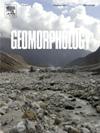基于知识约束的深度学习在黄土高原大尺度地貌分类中的应用
IF 3.1
2区 地球科学
Q2 GEOGRAPHY, PHYSICAL
引用次数: 0
摘要
地貌是自然地理学的基本组成部分,是地球表面系统的基础。准确的地貌分类是地貌学研究的核心内容,具有广泛的研究意义。然而,地球表面复杂的形态特征,受到各种内外部力量的影响,使得大规模地划定地貌边界具有挑战性。本研究采用知识约束下的深度学习方法对中国黄土高原100.90°-114.55°E和33.72°-41.27°n范围内的地貌进行分类。首先,基于黄土地形的水文特征和二元特征提取黄土地貌知识。然后,使用地形标签以及数字高程模型(dem)和图像来训练深度学习模型。第三,将训练好的模型应用于整个研究区,对黄土丘陵和黄土山脊进行分类。最后,对已分类的黄土塬、垄、丘、沟进行合并,实现黄土地貌的综合分类。利用5000个样本点对分类精度进行评价,结果表明,高原分类精度为88.01%,山脊分类精度为76.34%,丘陵分类精度为72.00%,沟谷分类精度为91.61%,总体精度为82.86%。与不使用知识作为约束相比,使用知识作为约束可以提高13%的分类准确性。与改进U-Net方法的对比分析表明,该方法可以获得更精确的地形边界,并优于现有方法。此外,在生态区域内对分类结果进行统计分析,发现地貌比例可以部分反映各区域的地貌发育特征。在未来的研究中,这种知识约束的分类方法有望在全球范围内应用。本文章由计算机程序翻译,如有差异,请以英文原文为准。
Knowledge-constrained deep learning for large-scale landform classification in the Loess Plateau
Landforms are a fundamental component of physical geography and form the foundation of the Earth's surface system. Accurate landform classification is a core task of geomorphological research and has broader implications for related studies. However, the complex morphological characteristics of Earth's surface, shaped by various internal and external forces, make it challenging to delineate landform boundaries on a large scale. In this study, we employed a deep learning method constrained by knowledge to classify landforms in the Loess Plateau, China, within 100.90°–114.55° E and 33.72°–41.27° N. First, the knowledge of loess landforms was extracted based on hydrological and binary characteristic of loess terrain. Then, landform labels, along with Digital Elevation Models (DEMs) and images, were used to train the deep learning model. Third, the trained model was then applied across the study area, where loess hills and ridges were classified. Finally, the classified loess tablelands, ridges, hills and gullies were merged to achieve a comprehensive loess landform classification. The accuracy of the classification was evaluated using 5000 sample points, yielding accuracies of 88.01 % for tablelands, 76.34 % for ridges, 72.00 % for hills, and 91.61 % for gullies, with an overall accuracy of 82.86 %. Using knowledge as a constraint improves classification accuracy by 13 % compared to not using it. A comparative analysis with the Modified U-Net method showed that our proposed method produced more accurate landform boundaries and outperformed the existing approach. In addition, the classification results were statistically analyzed within ecological regions, revealing that landform proportions can partially reflect the geomorphic development characteristics of each region. In future research, this knowledge-constrained classification method is expected to be applicable to a global scale.
求助全文
通过发布文献求助,成功后即可免费获取论文全文。
去求助
来源期刊

Geomorphology
地学-地球科学综合
CiteScore
8.00
自引率
10.30%
发文量
309
审稿时长
3.4 months
期刊介绍:
Our journal''s scope includes geomorphic themes of: tectonics and regional structure; glacial processes and landforms; fluvial sequences, Quaternary environmental change and dating; fluvial processes and landforms; mass movement, slopes and periglacial processes; hillslopes and soil erosion; weathering, karst and soils; aeolian processes and landforms, coastal dunes and arid environments; coastal and marine processes, estuaries and lakes; modelling, theoretical and quantitative geomorphology; DEM, GIS and remote sensing methods and applications; hazards, applied and planetary geomorphology; and volcanics.
 求助内容:
求助内容: 应助结果提醒方式:
应助结果提醒方式:


